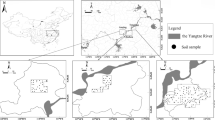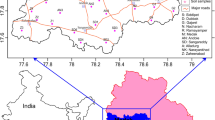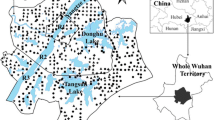Abstract
The concentrations of mercury and cadmium in surface soil along the three ring road with high traffic density from Beijing, China, were investigated. The concentrations of cadmium and mercury in urban soils were in the range of 0.086–1.59 and 0.16–3.68 mg kg−1, which exceeded the upper limits of potential toxic elements concentration for agricultural soils of China (PTE-MPC). The metal elements of cadmium and mercury showed similar spatial distribution and seasonal variations. Concentrations of cadmium and mercury in surface soil along the three ring road were significantly higher than previous reported values, which was attributed to the increased traffic density in Beijing. Results from this study demonstrated that the soil of the three ring road had endured severe cadmium and mercury pollution.
Similar content being viewed by others
Explore related subjects
Discover the latest articles, news and stories from top researchers in related subjects.Avoid common mistakes on your manuscript.
Vehicular traffic is a primary contributor to urban air pollution (Al-Khashman 2004; Bilos et al. 2001). Being exposed to airborne contaminants raised by traffic, humans might suffer from various health problems, such as pulmonary dysfunction, cardiovascular dysfunction, and certain types of cancer. Metals in urban soils have been shown to be very useful tracer of environmental pollution (Blake and Goulding 2002). Urban soils are known to have peculiar characteristics such as unpredictable layer, poor structure and high concentration of trace elements. They are the recipients of large amounts of metals from a variety of sources including industrial wastes, vehicle emissions, coal burning waste and other activities (Chen et al. 1997, 2008). Elevated concentrations of some metals in soil pose a threat to human health and biosphere by leaching into groundwater, entering the food chain through plant uptake, or directly by human consumption via wind blown dust or the hand-to-mouth pathway (Heng et al. 2004; Hu et al. 2006). Therefore, assessment of metal pollution in urban soil has become a major environment issue in many countries (Gallego and Ordonez 2002; Goovaerts et al. 1997; Liu et al. 2004).
In China, metal pollution in urban soil becomes serious with the rapid industrialization and urbanization during the last two decades (Yang et al. 2009). Though the geological background levels of metal were reported low in China, anthropogenic activities have been recently recognized to raise metal pollution in soil, water, air and plants, even affecting human health through direct intake or food chain (Cheng 2003). Furthermore, the continuously increasing traffic flows exerts heavy impacts on adjacent ecosystems. It composes a major source of metal pollution in urban soils. Some metals, presenting in the anti-wear substances added to lubrications, brake pads and tyres, were emitted to the environment by traffic. They were usually dispersed in relatively higher concentrations in the vicinity of the roads (Chary and Kamala 2008; Cui et al. 2005).
In this case, the sampling sites were on the side of the three ring road in the city of Beijing, China. The three ring road goes across five central districts, the main commercial, industrial and traditional areas of Beijing, including Haidian, Chaoyang, Chongwen, Xuanwu and Fengtai (Fig. 1). Since built in 1980s, the road, as the main traffic road in Beijing, has been experiencing the increasing traffic burden and could be an ideal sampling site. This study was conducted on the surface soil samples collected from the three ring road to investigate the spatial and seasonal variations of Cd and Hg pollution.
Materials and Methods
A systematic sampling strategy was conducted and 12 sampling sites were selected as shown in Fig. 1. The soil samples were collected in July, September, December 2009 and March 2010, respectively. Stainlesss hovels were used to collect the soil samples from a depth of 2–5 cm to reduce metal disturbance. The soil surface layer was removed before sampling. In addition, three soil sub-samples from each sampling site were collected as duplicate sample. All samples were put in airtight polyethylene bags and taken back to the laboratory. Before analysis, all soil samples were air-dried and passed through a 200 μm sieve. All samples were digested with HNO3 + H2O2 + HF (2:1:0.5, v/v) and analyzed by ICP-MS (Agilent 7500 CA) to determine the concentrations of Cd and Hg. Standard metal solutions used for the analysis were obtained from National Center for Standard Materials (China). For quality assurance, the certificated reference material, GBW 07423 (farmland soil) was used for the evaluation of measurement precision. The recovery values of metals of the samples were all >90%. Blanks were also conducted in each run both for the reagent and sample (Table 1).
The pollution index (PI) of each metal was used to assess the soil environmental quality. The PI was defined as the ratios of the heavy metal concentration in the study to the geometric means of metal of Beijing. The PI of each metal was calculated and classified as either low (PI < 1), middle (1 < PI < 3) or the high (PI > 3) (Chen et al. 2005).
The distributions of data were tested with the Shapiro–Wilk method (p < 0.05). All statistical treatments mentioned above was performed using Origin Pro 7.0 software.
Results and Discussion
Metal concentrations in soil were summarized in Table 2. In addition, the background values and upper limits of potential toxic elements concentration of the metals for agricultural soil of China (PTE-MPC) were also shown in Table 2 (CEPA 1990). Concentrations of Cd and Hg in the urban soils were in the range of 0.086–1.59 mg kg−1 (mean 0.55 mg kg−1) and 0.16–3.68 mg kg−1 (mean 1.67 mg kg−1), which exceeded the PTE-MPC for both mean and median, comparing to the soil standard values of China. Similarly, the concentrations of Cd in Xuzhou and Chengdu, and the concentrations of Hg in Guangzhou and Chengdu were also observed higher than PTE-MPC in previous study (Wei and Yang 2010). It could therefore be stated that Hg and Cd levels investigated in the three ring road, especially in the southern region, which was remote from direct influence of industrial sources, were at the higher level in a global perspective and could be used as a representative case of traffic pollution. Figure 2 listed the concentration distributions of collected samples near the three ring road. None of the elements showed the bell-shaped feature expected of a normal distribution. Among the findings, the histograms of all elements showed multi-modal features. Mixed influence factors, indicating geochemical and seasonal variables belonging to different contamination resources, could cause multi-modal features on a histogram. Since most statistical methods were generally designed for a single influence factor, the possible multiple influence factors were necessary to be treated separately. The spatial distributions and seasonal variable patterns of two elements were coincided with different trends within the study areas.
The PI index (Csample/Cbackground) was used to judge the pollution status of metals in soil. Figure 2 illustrated the spatial distributions of PI index in different seasons. The spatial distributions of metal concentrations were a useful aid to assess the possible sources of enrichment and to identify hot-spot area with high metal concentration. The elements of Cd and Hg showed similar spatial distributions coinciding with seasonal variations, which suggested the two metals might be derived from anthropogenic sources. Because the sampling sites were mainly associated with main roads where high traffic density was identified. The features suggested that these metals were probably originated from vehicular emission. Similarly, high level of Cd presented in the urban soil in Beijing was found in other work (Liu et al. 2007). However, elevated concentration of soil Hg in urban soil of Beijing of this study was a new finding. It was well known that atmospheric Hg could be accumulated in surface soil through wet and dry deposition. Coal and oil combustion was the most important source of global atmospheric Hg. Especially in China, about 75% of Hg emissions were attributed to the combustion of fossil fuels (Jiang et al. 2006). The seasonal variations of Hg and Cd were quite similar, showing a relatively low concentration in spring, and higher concentration in the other three seasons, respectively. As the wind and traffic (wheels of vehicles) could transport volatile element and therefore significantly affect the distribution of soil metals, more data should be collected in future work to investigate their influence on spatial distributions.
To identify the current and future land use is a key component of the site evaluation process. In this case, the current and the future land use is both recreational and residential. The soil exposure pathway, by which human and ecological receptors may be at risk, includes inhalation, ingestion, dermal, and the terrestrial food chain for ecological receptors (McLaughlin et al. 1999). Given that Hg and Cd pollution of traffic source that was observed near the three ring road of Beijing, it was necessary to evaluate the pollution status using PI index. The PI values varied from 1.43 to 70.34 for Hg and 0.94 to 16.41 for Cd, respectively. The areas with PI values > 3 accounted for 89.6% for Hg and 79.4% for Cd, indicating that heavy pollution of Hg and Cd in the majority of soils on the three ring road.
The accumulations of Cd and Hg in soil were of increasing concern because of their toxicity to human health and its detrimental effects on soil ecosystems (Cui et al. 2005). Traffic emission was regarded as the most important anthropogenic metal source in this study area. The contamination of Hg would come from the traffic emission through exhaust gas, whereas the Cd metal entered into the soil ecosystem through brake pads and tyres. Based on the results, it is important to control the vehicle numbers in Beijing, moreover, new gas effluent standard for traffic should be carried into execution as soon as possible.
References
Al-Khashman OA (2004) Heavy metal distribution in dust and soils from the work place in Korak Industrial Estate, Jordan. Atmos Environ 38:6803–6812
Bilos C, Colombo JC, Skorupka CN (2001) Source, distribution and variability of airborne trace metals in La Plata City area, Argentina. Environ Pollut 111:149–158
Blake L, Goulding KWT (2002) Effects of atmospheric deposition, soil pH and acidification on heavy metal concentrations in soils and vegetation of semi-natural ecosystems at Rothamsted Experimental Station, UK. Plant Soil 240:245–251
CEPA (Chinese Environmental Protection Administration) (1990) Elemental background values of soils in China. Environmental Science Press of China, Beijing
Chary NS, Kamala CT (2008) Assessing risk of heavy metals from consuming food grown on sewage irrigated soils and food chain transfer. Ecotoxicol Environ Safe 69:513–524
Chen TB, Wong JWC, Zhou HY (1997) Assessment of trace metal distribution and contamination in surface soils of Hong Kong. Environ Pollut 96:61–68
Chen T, Zheng Y, Lei M, Huang Z (2005) Assessment of heavy metal pollution in surface soils of urban parks in Beijing, China. Chemosphere 60:542–551
Chen T, Liu XM, Zhu MZ (2008) Identification of trace element sources and associated risk assessment in vegetable soils of the urban–rural transitional area of Hangzhou, China. Environ Pollut 151:77–78
Cheng SP (2003) Heavy metal pollution in China: origin, pattern and control. Environ Sci Pollut Res Int 10:192–198
Cui YJ, Zhu YG, Zhai RH (2005) Exposure to metal mixtures and human health impacts in a contaminated area in Nanning, China. Environ Int 31:784–790
Gallego JL, Ordonez R (2002) Investigation of trace element sources from an industrialized area (Aviles, northern Spain) using multivariate statistical methods. Environ Int 27:589–596
Goovaerts P, Webster R, Dubois JP (1997) Assessing the risk of soil contamination in the Swiss Jura using indicator geostatistics. Environ Ecol Stat 4:49–64
Heng T, Heuvelink GBM, Stein A (2004) A generic framework for spatial prediction of soil variables based on regression-kriging. Geoderma 120:75–93
Hu K, Zhang L, Li G (2006) Spatial patterns of soil heavy metals in urban-rural transition zone of Beijing. Pedosphere 16:690–696
Jiang GB, Shi JB, Fen XB (2006) Mercury pollution in China. Environ Sci Technol 40:3672–3678
Liu XM, Xu JM, Zhang MK (2004) Application of geostatistics and GIS technique to characterize spatial variabilities of bioavailable micronutrients in paddy soils. Environ Geol 46:189–194
Liu YJ, Zhu YG, Ding H (2007) Lead and cadmium in leaves of deciduous trees in Beijing, China: development of a metal accumulation index (MAI). Environ Pollut 145:387–390
McLaughlin MJ, Parker DR, Clarke JM (1999) Metals and micronutrients-food safety issues. Field Crops Res 60:143–163
Wei BG, Yang LS (2010) A review of heavy metal contaminations in urban soils, urban road dusts and agricultural soils from China. Microchem J 94:99–107
Yang P, Mao R, Shao H, Gao Y (2009) The spatial variability of heavy metal distribution in the suburban farmland of Taihang Piedmont Plain, China. C R Biol 332:558–566
Acknowledgments
The authors are grateful to the financial support of National Basic Research Program of China (No. 2007CB407303), The National Natural Science Foundation of China (40875082) and 2010 Seed Program of Beijing Academy of Science and Technology.
Author information
Authors and Affiliations
Corresponding author
Rights and permissions
About this article
Cite this article
Liu, Q., Liu, Y. & Zhang, M. Mercury and Cadmium Contamination in Traffic Soil of Beijing, China. Bull Environ Contam Toxicol 88, 154–157 (2012). https://doi.org/10.1007/s00128-011-0441-6
Received:
Accepted:
Published:
Issue Date:
DOI: https://doi.org/10.1007/s00128-011-0441-6






